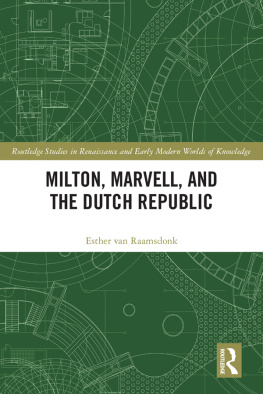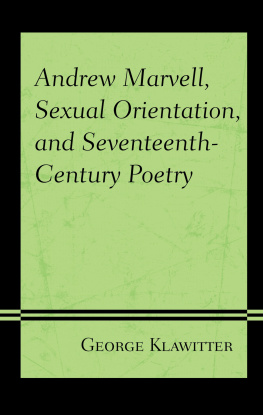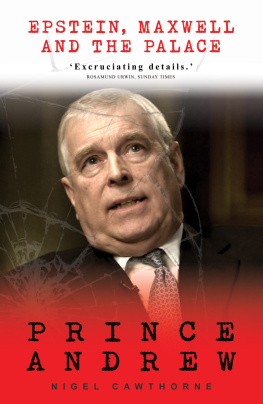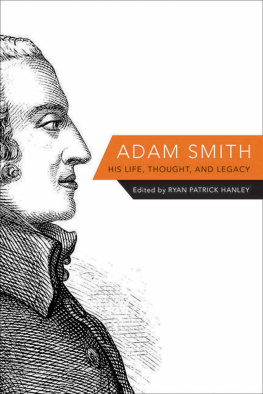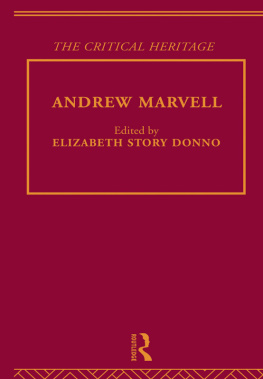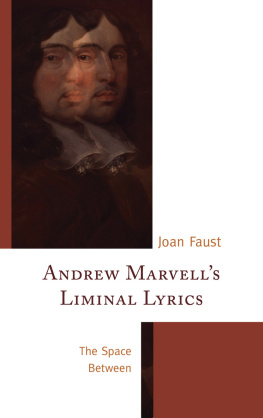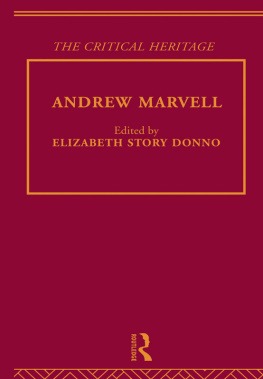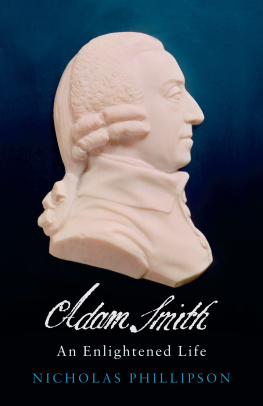ANDREW MARVELL
ANDREW MARVELL
The Chameleon

NIGEL SMITH
YALE UNIVERSITY PRESS
NEW HAVEN AND LONDON
Copyright 2010 Nigel Smith
All rights reserved. This book may not be reproduced in whole or in part, in any form (beyond that copying permitted by Sections 107 and 108 of the U.S. Copyright Law and except by reviewers for the public press) without written permission from the publishers.
For information about this and other Yale University Press publications, please contact:
U.S. Office:
sales.press@yale.edu www.yalebooks.com
Europe Office: sales@yaleup.co.uk www.yaleup.co.uk
Set in Minion Pro by IDSUK (DataConnection) Ltd
Printed in Great Britain by MPG Books, Bodmin, Cornwall
Library of Congress Cataloging-in-Publication Data
Smith, Nigel, 1958
Andrew Marvell: the chameleon / Nigel Smith.
p. cm.
Includes bibliographical references.
ISBN 9780300112214 (alk. paper)
1. Marvell, Andrew, 16211678. 2. Poets, EnglishEarly modern, 15001700Biography. 3. LegislatorsGreat BritainBiography. 4. Marvell, Andrew, 16211678Political and social views. 5. Politics and literatureGreat BritainHistory17th century. 6. Great BritainPolitics and government16601688. I. Title.
PR3546.S65 2010
821'.4dc22
2010009130
A catalogue record for this book is available from the British Library.
10 9 8 7 6 5 4 3 2 1
CONTENTS
ILLUSTRATIONS
P LATES
1 St German's Church, Winestead (photo: Alan Blackshaw).
2 Holy Trinity Church, Hull ( English Heritage/photo: Bob Skingle).
3 Wenceslaus Hollar, Kyngeston vpon Hull (1640) (Thomas Fisher Rare Book Library, University of Toronto).
4 Henry Hawkins, Partheneia Sacra ([Rouen], 1633), sig. [Aviv]) (courtesy of the Firestone Library, Princeton University, NJ).
5 Map of Clerkenwell, Smithfield and environs (1654) (detail) by Thomas Porter (The British Library).
6 Gian Lorenzo Bernini, Apollo and Daphne (16225) (Borghese Gallery, Rome)
7 Sixteenth-century representation of the statue of Pasquino from Antoine Lafrry, Speculum Romanae Magnificentiae (1575) (Marquand Library of Art and Archaeology, Princeton University, NJ).
8 Attributed to Jusepe Leonarde, Palace of the Buen Retiro in 16367 (detail) (Palacio Real de El Pardo, Madrid).
9 Samuel Cooper, Oliver Cromwell (1649) ( National Portrait Gallery, London).
10 Unattributed, portrait of Robert Overton (16524) ( National Portrait Gallery, London).
11 William Faithorne, after Robert Walker, Thomas Fairfax, 3rd Baron Fairfax of Cameron ( National Portrait Gallery, London).
12 Daniel King, Appleton House (c. 165560), Ms Gough Maps 1 (Bodleian Library, Oxford).
13 Pieter Nason, Oliver St John (1651) ( National Portrait Gallery, London).
14 Pieter Nason, Walter Strickland (1651) ( National Portrait Gallery, London).
15 Robert Walker, Oliver Cromwell (1653) (by courtesy of His Grace, the Duke of Grafton).
16 After Franz Cleyn, John Dutton, Lodge Park, Gloucestershire ( National Trust Photo Library/John Hammond).
17 Lodge Park, Gloucestershire ( National Trust Photo Library/Nick Meers).
18 Unattributed, Nettleton portrait of Andrew Marvell (c. 1657) ( National Portrait Gallery, London).
19 Samuel Cooper, Oliver Cromwell (c. 1655) ( National Portrait Gallery, London).
20 Unattributed, Richard Cromwell (c. 16505) ( National Portrait Gallery, London).
21 Copy of the Seal of the Parliament of the Commonwealth of 1659, imitating the Great Seal of 1651, from George Vertue, Medals, Coins, Great-Seals, Impressions, from the elaborate works of Thomas Simon (1780) (The British Library).
22 Engraved frontispiece and title page of Andrew Marvell, Miscellaneous Poems (1681) (courtesy of the Firestone Library, Princeton University, NJ).
23 William Faithorne, John Milton (1670) (courtesy of the Firestone Library, Princeton University, NJ).
24 William Faithorne, Charles Howard, 1st Earl of Carlisle. From Guy Mige, A Relation of Three Embassies (1669), frontispiece (courtesy of the Firestone Library, Princeton University, NJ).
M APS
PREFACE AND ACKNOWLEDGEMENTS
This biography was researched and written in the years following the publication in 2003 of my edition of Andrew Marvell's poems in the Longman Annotated English Poets series. The initial research, which grew out of the work for the poetry edition, but which had far more detailed recourse to the kinds of archive in which life records are contained, took place from 2004 to 2006, followed by a sustained period of further research, reflection and writing. During the last three decades, and especially during the last fifteen years, Marvell has ceased to be regarded merely as an interesting literary figure who straddled the worlds of poetry and politics, and who wrote a handful of important poems, but has become the focus of such attention as befits an author of high literary quality: one whose peculiar greatness brings him into the first division of seventeenth-century authors, second only to Milton, and in the company of Jonson, Donne and Dryden. In addition to recent scholarly editions of the poetry, there is now also a full and properly annotated edition of Marvell's prose (edited by Annabel Patterson, Martin Dzelzainis and N.H. Keeble 2 vols, 2003), the first time Marvell's prose has been published in complete form for more than a hundred years. In the years after the appearance of these editions academic interest in Marvell blossomed to the extent that there is now an international society dedicated to the study of Marvell in addition to a noticeable increase in scholarly gatherings and publications on him and his writings.
Modern biography of Marvell is understandably scarce. Augustine Birrell's study of 1905 was succeeded by Pierre Legouis's remarkable thse of 1928, the first extensively documented work that brought together the double career of politician and poet. Legouis's findings were published in English, compressed and revised, in 1965, and a new life, taking account of scholarly discovery from the 1960s to the 1990s, was published in 1999 by Nicholas Murray. The purpose of my own biography is to make Marvell known to the widest possible readership, in the light of the most recent editions and scholarly work, much of which was unknown to Murray. I offer my own interpretation of events, circumstances and writings, but I am deeply indebted to Birrell, Legouis and Murray and to all of Marvell's biographers, from Thomas Cooke to Hilton Kelliher, the author of Marvell's life in the recent Oxford Dictionary of National Biography, for helping to represent the life of a man who preferred to be secretive, and for thinking it was a life worth shaping as biography.
My greatest debt in these pages is to Nicholas von Maltzahn, whose monumental chronology of Marvell's life records (2005) establishes the new standard to which all Marvell study must rise and whose authority on Marvell's life records is now unsurpassed. I am deeply grateful for all of his help, his willingness to share information, his patience and the astute judgement displayed when reading my manuscript. As a result the exposition is sharper, and he has saved me from many errors. I must also thank two other leading Marvell scholars whose knowledge, insight and close friendship have been just as valuable in the construction of this life: Annabel Patterson (our greatest critical advocate of seventeenth-century political literature) and Martin Dzelzainis. These three are my touchstones of judgement. Other Marvellians who have directly helped me in research and writing include Warren Chernaik, Alastair Fowler, Vitaly Eyber, Estelle Haan, Paul Hammond, Derek Hirst, Edward Holberton, Art Kavanagh, N.H. Keeble, George Klawitter, Sean McDowell, Paul Mathole, Ian Parker, Timothy Raylor, Gilles Sambras and Steven Zwicker. A longer list of Renaissance and seventeenth-century experts who have helped with discussions sometimes dating back many years includes Sharon Achinstein, John Barnard, Maureen Bell, Tom Corns, John Creaser, Ariel Hessayon, Ann Hughes, John Kerrigan, Timothy Kircher, Charles-Edouard Levillain, Rhodri Lewis, David Loewenstein, Sarah Mortimer, David Norbrook, William Poole, Steve Pincus, Diane Purkiss, John Rogers, Peter Rudnytsky, George Southcombe, Phil Withington, Blair Worden and the two anonymous readers for the publisher.
Next page

